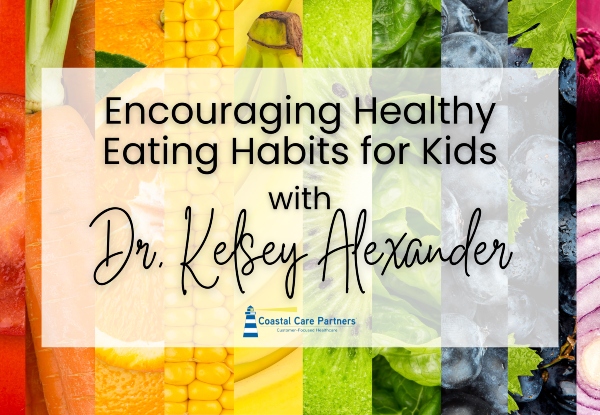Savannah pediatrician Dr. Kelsey Alexander on healthy eating habits for kids

Savannah Pediatrician Dr. Kelsey Alexander on healthy eating habits for kids
Below is a guest post by Savannah pediatrician Dr. Kelsey Alexander @ Coastal Care Partners’ new Concierge Pediatric Clinic
Let me preface this by saying that I am not a nutritionist. However, I do want to teach my kids to have a healthy relationship with food. As parents, the goal is to help kids balance their food choices even when we are not with them. To do this, allow your kids a safe space to learn and make healthy food decisions at home.
While there is no perfect way to talk to kids about food, it’s best to keep things fun and positive. I’d like to share a few evidence-based ideas that I am currently working on with my children!
Neutralize Food
Food is food. Instead of categorizing foods as “good” or “bad,” change the conversation to talking about foods that make them strong or give them the energy to do their favorite things. Conversations about the color, shape, smell, taste, and texture of foods can also help make kids more comfortable with different kinds of food.
Taking food out of wrappers recognizable to children can also help neutralize foods. Giving snacks to your kids out of the packaging and in smaller portions with other foods allows them to enjoy the food while saving room for other food.
Allowing all types of food rather than restricting certain food groups is also helpful. Consider serving “bad” foods with the meal instead of afterward. At the start, your child may only eat the “bad” food, but with time the excitement around that food will fade, leading them to explore other food on their plate.
Food should never be “earned.” Pushing children to eat more “good” foods to earn “bad” foods can do three things:
It makes the “bad” foods seem more enticing.
It can make children dread the “good” food.
It makes kids eat when they aren’t necessarily hungry instead of listening to their bodies when they are full.
Talk About What Different Foods Can Do for Their Body
All foods give us energy, just some more than others. Discuss macronutrients in a simplistic way with your children. For example, protein helps build strong muscles and helps fix our body when it’s hurt. Carbohydrates include starches, grains, and sugars; starches and grains are our body’s main energy sources. Sugars, on the other hand, can give us energy quickly, but it does not last as long. Fats absorb vitamins, build cells, and provide long-term energy; plant-based and fish fats help keep our hearts healthy.
Eating the colors of the rainbow is also a great way to introduce the functions of different foods for the body and encourage eating a variety of foods. Explain that we need to eat a lot of different foods to do the things we love. For example, red foods support a healthy heart and improved memory. Orange and yellow foods help us not get sick and support our eyes and heart. Green foods are great for the eyes, bones, and teeth. Blue and purple foods can improve memory and help us not get sick.
Encourage Kids to Listen to Their Bodies
Teaching children to listen to their bodies is essential. Ensure they eat only when they are hungry and stop eating when they are full. It’s also important to remember that eating habits are not the same for everyone. While some eat more, others eat less, and that is okay!
Rather than encouraging “Clean Plate Clubs,” it helps to give the same reaction no matter how much food your kids eat. One way to plan meals is to give a 30-minute window for eating. Then, when the meal is over, any leftovers can be put in the fridge for the next day—no need to make a new meal or give liquid calories if they didn’t eat.
Consider allowing kids to serve portions for themselves. Giving them autonomy to make their own decisions and decide what they eat can be empowering. While you should encourage them to try new foods, you should not force them.
Kids can often seem fixated on certain foods. Make sure to acknowledge that desire and make that food seem available instead of restricted. To do this, try saying things like, “I know you love (favorite treat). Let’s leave the rest, so there is more for tomorrow,” or “Let’s add that to the grocery list to enjoy soon.”
As you eat with your children and guide their relationship with different foods, you’ll help give them the knowledge and confidence they need to make healthy decisions for themselves. Making these conversations normal, fun, positive, and informative is a great way to start!
_________
Coastal Care Partners, 4B Skidaway Village Walk, Savannah, GA 31411, 912.598.6312. Coastal Care Partners Concierge Pediatric Clinic is a SouthernMamas.com advertiser










































